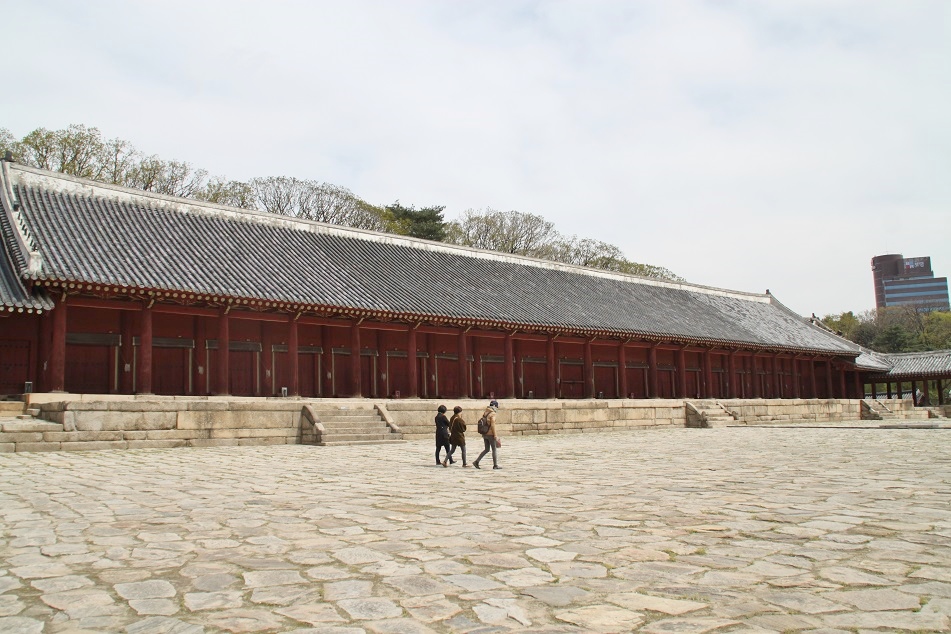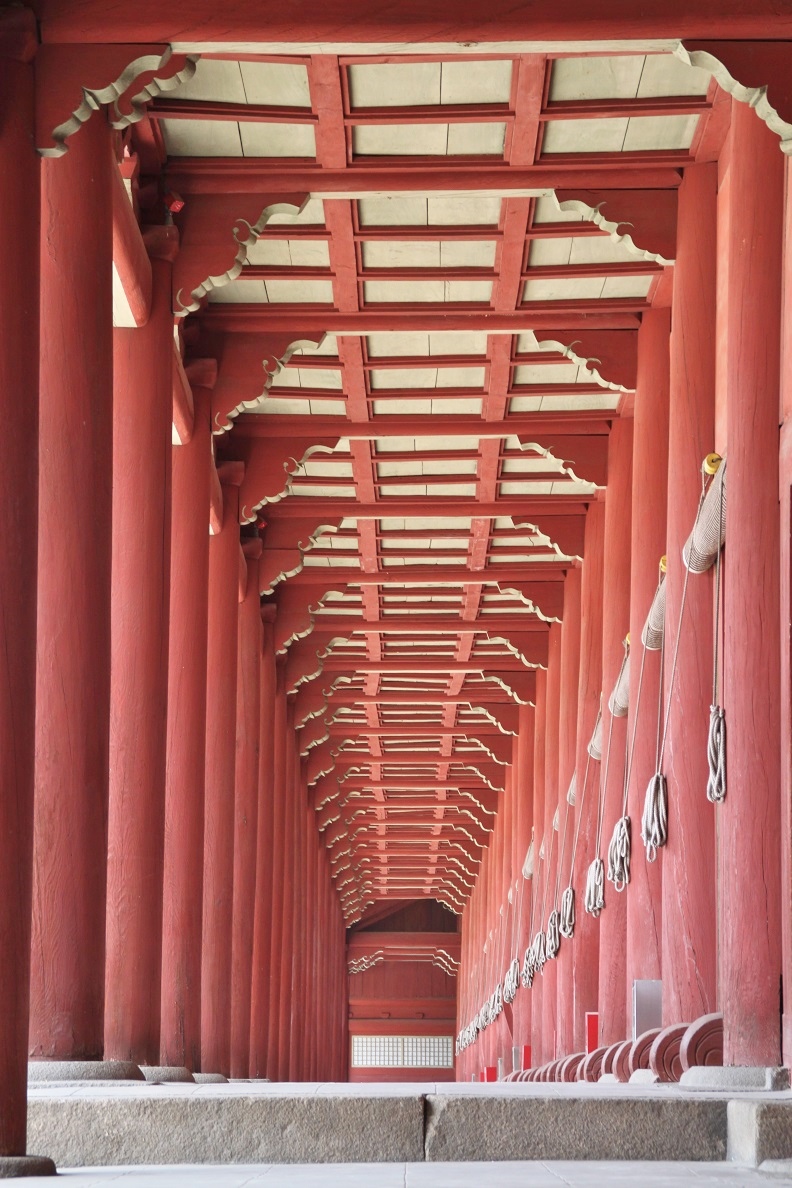In the past, great temples, shrines and places of worship were often constructed to signify the rise of new kingdoms and empires, or to commemorate significant events, or even to appease gods and goddesses. Normally a great amount of time and wealth was expended, and the work involved the most talented sculptors and artisans to create richly-decorated structures built not only to last, but also – and most importantly – to impress. All but a few of those structures followed this pattern.
In 1392, Yi Seong-gye who at that time was the general of the Goryeo dynasty – which controlled much of the Korean peninsula – overthrew King Gongyang to become the new king himself. This event effectively put an end to the 474-year-old dynasty and marked the beginning of the Joseon dynasty which would come to rule the peninsula even longer than its predecessor. Yi Seong-gye took the name King Taejo and under his rule Confucianism became the state ideology, replacing Buddhism which had enjoyed a special status as the preferred religion of the previous dynasty.
A few years into his reign, King Taejo commissioned Jongmyo, a shrine dedicated to honoring the king’s ancestors, one of the most important rites in Confucian tradition. Built at the heart of what is now the city of Seoul, the shrine’s architectural style is a testament to the new dynasty’s focus on good governance, education and a strong work ethic rather than artistic endeavors (as I learned from my visit to the National Museum of Korea a few days earlier), emphasizing functionality with a relatively austere look.
The palaces were where the kings and the royal family used to live, while the tombs were where they were buried. Jongmyo, on the other hand, was where the ancestors’ spirit tablets were kept; it was meant to be a place where the living met the deceased. And for this purpose, a three-row stone pathway was laid from the shrine’s south gate all the way to the core structures within the walled compound; the elevated center row was reserved for the spirits, the right side (the east road) for kings, and the left side (the west road) for crown princes.
During the rule of the Joseon dynasty, when a king died a spirit tablet was created and kept in the palace for a traditional three-year mourning period after which it was then moved to Jongmyo. Jeongjeon – originally built in the late 14th century – is the oldest of the two halls where the spirit tablets are enshrined. Comprising 19 so-called spirit chambers spanning 101 meters, it is believed that the structure was once among the longest wooden buildings in Asia. Even today its most striking appearance is its long dimension, although it remains true to the Confucian aesthetics: architecturally simple which relies on repetition. When the chambers of Jongjeon ran out of space, another hall called Yeongnyeongjeon was constructed to its northwest.
When Japan invaded Korea in the late 16th century, they burned down symbolically-important buildings, including the royal palace of Gyeongbokgung and the old ancestral halls of Jongmyo, to demoralize the Koreans. However, the sudden death of Toyotomi Hideyoshi – the de facto ruler of Japan – in 1598 forced the invading forces to retreat. Subsequently, Jeongjeon and Yeongnyeongjeong were reconstructed several years later and Jongmyo resumed its role as the principal shrine of the Joseon dynasty. Despite the destruction of the previous structures, the original spirit tablets were fortunately removed from the halls prior to the blaze, and safely hidden in the house of a commoner.
In 1995, long after the end of Korea’s last monarchy, Jongmyo was inscribed as a UNESCO World Heritage site, becoming one of the first sites in South Korea added to the list. The 17th-century reconstruction survives to this day, as do the spirit tablets. Nevertheless, since the time of the monarchs has long gone, no kings and crown princes walk on the right and left sides of the stone pathway now. The central elevated path, however, is still reserved for the spirits, and reminders of this are placed at regular intervals to make sure the old tradition is respected even by those who no longer practice it – a real challenge in fast-changing South Korean society and amid the influx of foreign visitors who come from different cultural backgrounds.

















This is wonderful! I’m reblogging to sister site “Timeless Wisdoms”
LikeLike
Much appreciated, Ana!
LikeLike
😊
LikeLike
Pingback: Jongmyo: Walking alongside the Spirits – Timeless Wisdoms
That is a fascinating piece of Korean past complete with pictures. The belief in afterlife seems to have deep roots in ancient civilisations the world over. Its manifestations and influence upon cultures have different outcomes however.
LikeLike
I think the belief in afterlife is so important in a lot of cultures and religions because to many people it acts as a reminder of why they should do good things in life — although that clearly doesn’t stop some religious fanatics and extreme-right politicians (who often use religion to gain support) from harming others for their own agenda.
LikeLike
Any religion, or system of belief for that matter, can be twisted to diabolical and nefarious ends. Historically, younger religions have been known to be aggressive and cruel, but as unfortunate as it may sound, certain religions seem to be the very anathema to peaceful coexistence regardless of their ages. In the end, it is more the vested interests of those propagating an ideology than the dictats of the so called holy scriptures that devastate a flourishing societies. Nazism in the past and of late the Wahabi fundamentalism/ISISism are proof enough of the bitter fact.
LikeLike
And when those interests are backed by more-than-sufficient funding and disseminated through sophisticated online and offline networks, what we get is an exponential increase in the scale of destruction.
LikeLiked by 1 person
Nice post and beautiful photos. Brought back memories of a too-quick visit to Seoul in fall. The gardens look wonderful at that time.
LikeLike
Thank you. I have seen some photos of Seoul in fall, and I particularly fell in love with the shots of Gyeonghoeru Pavilion at Gyeongbokgung Palace complex framed by autumn foliage.
LikeLike
What a beautiful shrine and so much history!
LikeLike
Luckily I went there when there was sun because I wasn’t too lucky with the weather during my short stay in Seoul.
LikeLike
Such riveting history and traditions. Your storytelling, Bama, is a dose of immense cultural immersion. Especially loved your photography in this adventure. Safe travels to your next destination!
LikeLike
Always appreciate your kind words, Jess. I just returned from a short trip to visit some centuries-old temples and ruins in eastern Java, but travel-wise September will be a rather dull month. Hope life takes you to more exciting destinations too!
LikeLiked by 1 person
Pingback: Jongmyo: Walking alongside the Spirits — What an Amazing World! – KALIST JASTINE
What a wonderful and ancient culture! I’m so grateful to see your pictures because I’m much too old to survive a trip to these places
LikeLiked by 1 person
Well, I guess you should never say never. 🙂 Thanks for reading, Adelheid.
LikeLike
Beautiful, Bama. A sense of peace and calm pervades the whole site. The repetition of columns and elevated stone foundations share similarities with some parts of Chichen Itza (a post coming soon), and the three-row stone path is really fascinating — so much reverence given to the spirit world. It must have been such a different time, but the grandeur certainly remains.
LikeLike
Oh you really know how to pique my curiosity, Kelly! Can’t wait to read that post of yours on Chichen Itza. I always enjoy visiting ancient places where we can imagine how life was like in different parts of the world, and the connection the locals made with their counterparts over the mountains and across the oceans, allowing cultural exchanges to happen.
LikeLiked by 1 person
Just like when we finally meet someday! 🙂
LikeLiked by 2 people
I love the concept of a spirit tablet and the elevated walkway that is still reserved for spirits. The Jeongjeon is stunning (grand, but at the same time simple and soothing). Your vertical photo with the columns is particularly striking. As usual, impressive history lesson Bama; thanks!
LikeLike
Jongmyo is the only place that I’ve been to where this kind of tradition was (and still is to some extent) practiced. Can you imagine how impressive it must have been for the locals when Jeongjeon was completed! Even for modern-day visitors it still is a grand monument, as you said, despite its rather austere decorations. Thanks for reading, Caroline!
LikeLike
What a lovely reminder of a city and country I’d love to revisit. Wandering the grounds of Jongmyo Shrine was the perfect way to end our short trip to Seoul – I was a bit surprised to find it so peaceful even around midday. There’s an inherent beauty in the simplicity of the structures; the distinct lack of ornamentation really allows us to appreciate those wonderful colonnades and tiled roofs for what they are.
LikeLike
Oh you know how much we still have to see in Seoul, and all those dishes we had to skip because of our limited time. I’m really glad it was mostly sunny on our last day in Seoul, and a visit to Jongmyo Shrine was a nice conclusion to the incredibly short trip (better spend at least a week next time!). Seeing those cherry blossoms within the shrine’s grounds was also a nice treat before leaving for the airport. Now I’m curious to see other Confucian shrines (and the ones in China).
LikeLiked by 2 people
This sounds like a very powerful and peaceful place Bama. A lot of history there. And that building is amazing.
Alison
LikeLiked by 1 person
This is a kind of place best explored in a quiet ambiance, which how it exactly was during my visit. Although I’m a big fan of elaborate carvings, places like Jongmyo and some temples in Japan with their simple aesthetics certainly have their own allure.
LikeLiked by 1 person
You seem to have had the place almost to yourselves that day! I always find a lot of tranquility in simple architecture, and this is no exception. The history of the stone pathway is very cool, and I did wonder whether people used it now (got my answer later in the post!).
LikeLike
I think simple architecture is usually applied with harmony with nature in mind, hence the soothing effect it creates to some people — and it’s probably cheaper and faster to build as well. You might want to visit this place next time you’re in Seoul, Lex. Remember to watch your step!
LikeLiked by 1 person
Wow amazing pictures and they really made me wanna visit Korea someday!
LikeLike
Thanks Lina. South Korea has so much to offer. I wish I had more time in Seoul!
LikeLike